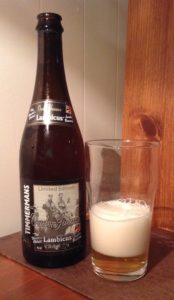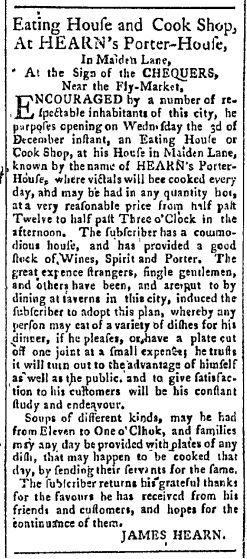 On 2 December 1783, James Hearn had a noticed placed in the New York Morning Post for his new business, opening the next day in Maiden Lane. Hearn’s Porter-House would offer wines, spirits and porter as well as a variety of dishes hot and in any quantity the single gentleman might desire. He even offered take away meals to anyone “sending their servants for the same.” A particular point is made about his soup. And then you notice the hours of operation. The soup is available from 11 am to 1 pm. The meals will be served from 12:30 noon to 3:30 pm. There’s a certain level of constraint at play.
On 2 December 1783, James Hearn had a noticed placed in the New York Morning Post for his new business, opening the next day in Maiden Lane. Hearn’s Porter-House would offer wines, spirits and porter as well as a variety of dishes hot and in any quantity the single gentleman might desire. He even offered take away meals to anyone “sending their servants for the same.” A particular point is made about his soup. And then you notice the hours of operation. The soup is available from 11 am to 1 pm. The meals will be served from 12:30 noon to 3:30 pm. There’s a certain level of constraint at play.
One of the great things about researching through newspaper archives is how everything is contextualized for you. It is easy to think, read and write about beer in a bubble if all you look at is information about beer. The notice for Mr. Hearn’s new business is placed in the newspaper one week after New York’s Evacuation Day, the day when the last of the British troops left the City after months of evacuations of the Loyalists who became one of the foundations of the nation to the north, Canada. Just two weeks before the proposed opening of the Porter-House, the Governor of New York placed a Proclamation in the Royal Gazette on 19 November 1783, the last edition, confirming how the withdrawal of British troops would occur. Notice that the Governor placing the ad was George Clinton and not Royal commander Sir Guy Carleton. The notice was published on page three.
So, why was it a porter-house? Porter was certainly prized in the years after the end of the American Revolution. As we saw a few weeks ago, in 1798 Caleb Haviland’s porter vault in what is now Lower Manhattan stocked both London porter and American porter. It was “in the best possible order” – ripe and brisk. But the relationship with the drink started at least half a century before that. In the New York Gazette of 5 February 1750, an extract of a letter was published from a new colony at Nova Scotia, written the previous August, praising the provisions… except the lack of “a Pot of good London Porter and Purl.” The earliest advertisement that I have seen for porter in New York City was published in the same paper on 23 December 1751 in a mixed cargo from Scotland* containing cloths and linens, steel and writing paper… plus usquabaug – aka whisky. It appears late in quite a long list of goods. One year later on 18 December 1752, an ad is placed again in the Gazette which places the porter right to the forefront in a range of sizes from butts to five gallon barrels:

One year on, in December 1753 the same William Wright** has a store open. It’s at the city’s docks near the
Royal Exchange a store called the
London Porter-House. These initial offerings are a few years before the boom in ads about
Taunton ale that appear to be concurrent with the 1754 start of the
French and Indian War, the North American campaign within the global Seven Years War, and particularly the
boosting of the troops in 1757-58. By that point, others are selling the beer not only in
New York but also up
in Albany nearer the battle front against New France. By the end of the 1750s, the cross-ocean trade in porter and a variety of English ales is well established with literally hundreds of notices for porter appearing in New York newspapers over the following years.
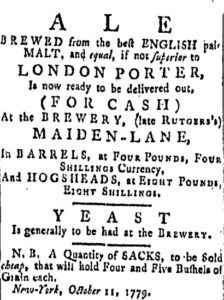 Jumping ahead, we find this ad from 1779 – the middle part of the war – which sets out some very interesting things. If you read it carefully, you will see it is not an ad for porter but an ad for a beer that is claimed to be as good as London’s porter. Imported porter is the standard to be met in the marketplace. The brewery is the one in Maiden Lane which has been taken over from the Revolutionary Rutgers clan of brewers. It’s brewed with English grain, which would be reasonable given how the city was surrounded by fields better known as “no man’s land.” War is bad for beer. But maybe not so bad for beer importation. Even in the middle of 1781, porter was being imported and made available along with other pleasures such as double spruce ale and coffee. By the summer of 1783, well after the impending surrender is inevitable, things are not as pretty. The Royal American Gazette of 7 August 1783 shows that everything is for sale: the billiards table in a house being advertised for leave, plenty of mess beef and pork in barrels, passage for your family to Canada and – yes – still those bottles of porter. All offered in return for cash or, as one notice states, “light and foreign gold taken in payment.” A few weeks later, the British are gone and Mr. Hearn has opened his Porter-House.
Jumping ahead, we find this ad from 1779 – the middle part of the war – which sets out some very interesting things. If you read it carefully, you will see it is not an ad for porter but an ad for a beer that is claimed to be as good as London’s porter. Imported porter is the standard to be met in the marketplace. The brewery is the one in Maiden Lane which has been taken over from the Revolutionary Rutgers clan of brewers. It’s brewed with English grain, which would be reasonable given how the city was surrounded by fields better known as “no man’s land.” War is bad for beer. But maybe not so bad for beer importation. Even in the middle of 1781, porter was being imported and made available along with other pleasures such as double spruce ale and coffee. By the summer of 1783, well after the impending surrender is inevitable, things are not as pretty. The Royal American Gazette of 7 August 1783 shows that everything is for sale: the billiards table in a house being advertised for leave, plenty of mess beef and pork in barrels, passage for your family to Canada and – yes – still those bottles of porter. All offered in return for cash or, as one notice states, “light and foreign gold taken in payment.” A few weeks later, the British are gone and Mr. Hearn has opened his Porter-House.
Why a porter-house? It was a last luxury of the previous regime. It is stored in cellars and is best when left to age down there. It needs to ripen if it’s going to be brisk. So, in the weeks and months after the peace breaks out and folk like the hatters Bickers* and Son are returning from the war triumphant, the goods in storage needed to be put to use. The porter still needed to be drunk. Mr. MacPherson had the same idea and opened his porter house a few weeks before the British left. Folk were making do as the new nation had just begun to make its way.
*I did not know until today that a “snow” was a sailing ship somewhat similar but distinct from a “brig.”
** presumably.
*** a rather capable man for a hatter, Colonel Bickers.
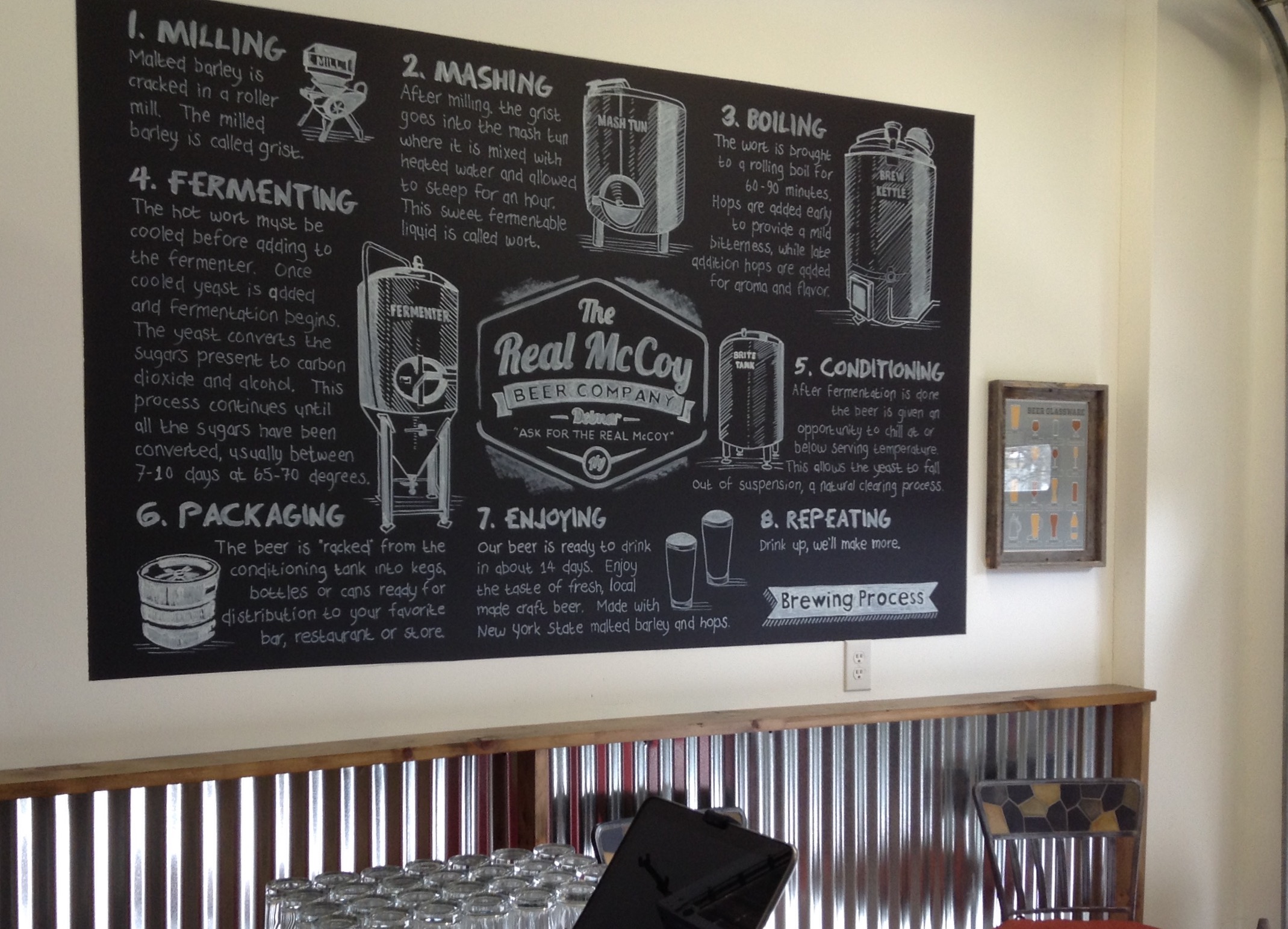 Not just Albany. Delmar, too. Delmar! Land of Craig’s youth. We sat at Real McCoy with owner and sign maker Mike Bellini and his pal Jay, a pro ciderman. I like a one-person brewery. Ron said it was the set up he dreamed of for himself. He was preaching the double brown gospel. Research. Comparing notes. Overly precious hipster nano failure v. single hop and malt explorations. The height of barley stalks and why. Maybe. Local hops were passed around. Forgot to mention the spruce beer idea, that coniferous flavouring predates DIPAs in the repetior.
Not just Albany. Delmar, too. Delmar! Land of Craig’s youth. We sat at Real McCoy with owner and sign maker Mike Bellini and his pal Jay, a pro ciderman. I like a one-person brewery. Ron said it was the set up he dreamed of for himself. He was preaching the double brown gospel. Research. Comparing notes. Overly precious hipster nano failure v. single hop and malt explorations. The height of barley stalks and why. Maybe. Local hops were passed around. Forgot to mention the spruce beer idea, that coniferous flavouring predates DIPAs in the repetior.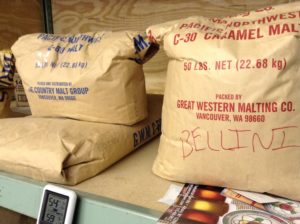 Everywhere we go Canadian malt is the backbone of NY craft brewing. Good to see. It’s good to be helpful. Definitely some sort of brown ale revival going on. And local ciders everywhere. 2014’s fruit salad obsession may just be history. Wouldn’t that be nice. Yesterday, Gerry L. was with us for a couple of hours and was corroborating and filling in gaps in 1700s NYC. And backdating schenck and lager. Was it just a new word layered on existing practice before the Panic of 1837? Maybe.
Everywhere we go Canadian malt is the backbone of NY craft brewing. Good to see. It’s good to be helpful. Definitely some sort of brown ale revival going on. And local ciders everywhere. 2014’s fruit salad obsession may just be history. Wouldn’t that be nice. Yesterday, Gerry L. was with us for a couple of hours and was corroborating and filling in gaps in 1700s NYC. And backdating schenck and lager. Was it just a new word layered on existing practice before the Panic of 1837? Maybe.


 Jumping ahead, we find this ad from 1779 – the middle part of the war – which sets out some very interesting things. If you read it carefully, you will see it is not an ad for porter but an ad for a beer that is claimed to be as good as London’s porter. Imported porter is the standard to be met in the marketplace. The brewery is the
Jumping ahead, we find this ad from 1779 – the middle part of the war – which sets out some very interesting things. If you read it carefully, you will see it is not an ad for porter but an ad for a beer that is claimed to be as good as London’s porter. Imported porter is the standard to be met in the marketplace. The brewery is the 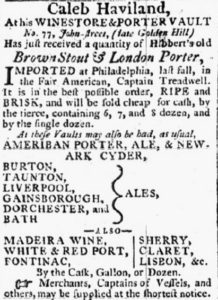
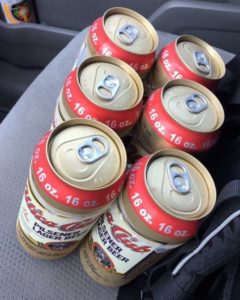
 The last year has been the scene of many a revelation when it comes to my relationship with beer. Among other things, out of nowhere two fabulous breweries opened up in my immediate vicinity after years of claiming my town was the least served by fresh beer for its size in the northeastern bit of North America. One is
The last year has been the scene of many a revelation when it comes to my relationship with beer. Among other things, out of nowhere two fabulous breweries opened up in my immediate vicinity after years of claiming my town was the least served by fresh beer for its size in the northeastern bit of North America. One is 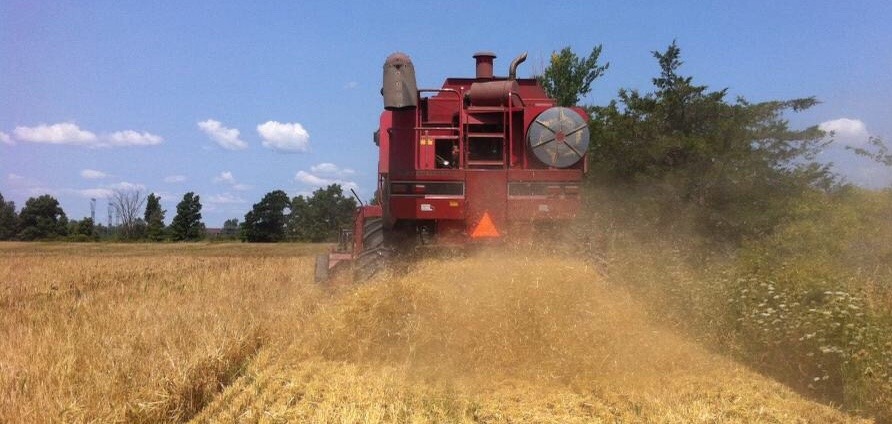
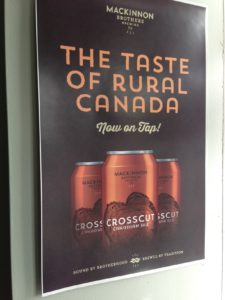 They already do. As part of the long weekend, we’ve been eating out a bit. Friday night, I went to
They already do. As part of the long weekend, we’ve been eating out a bit. Friday night, I went to 